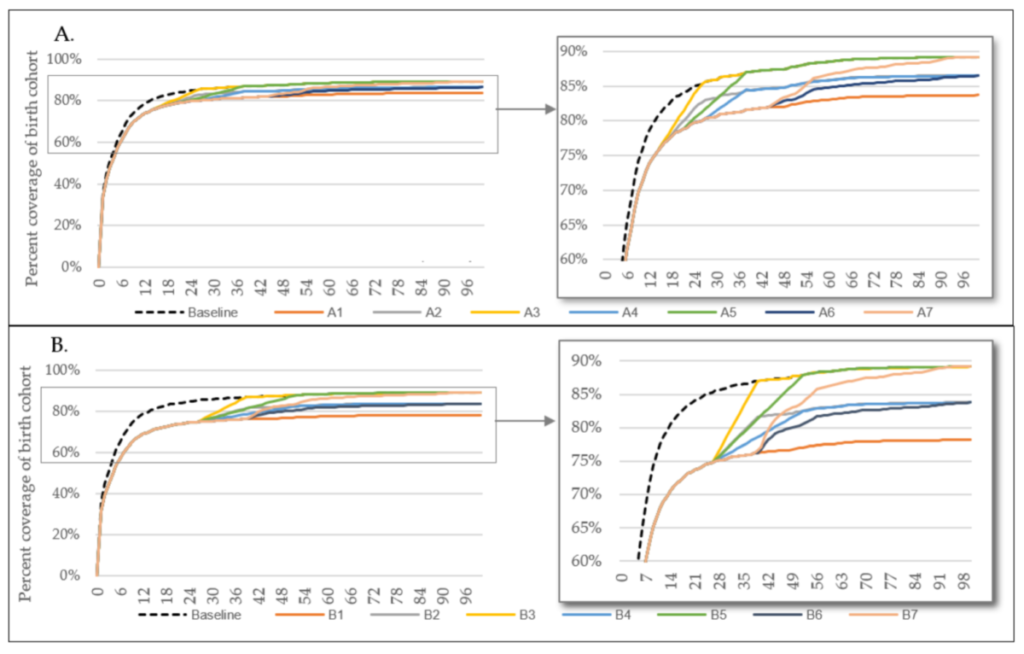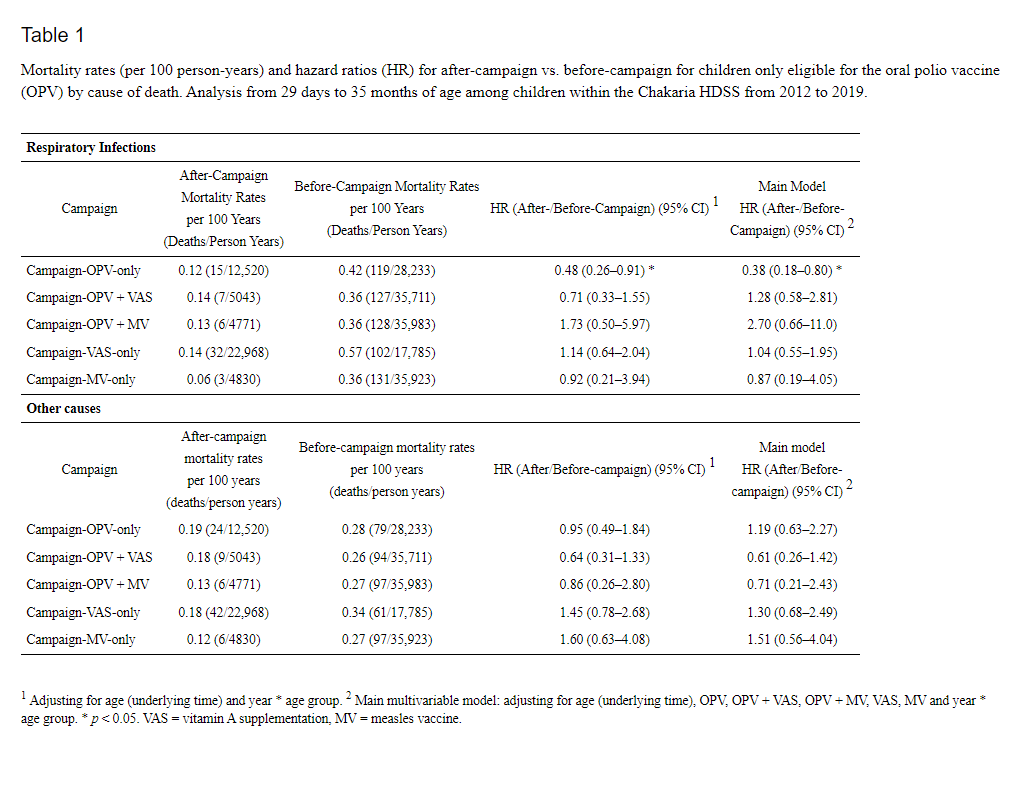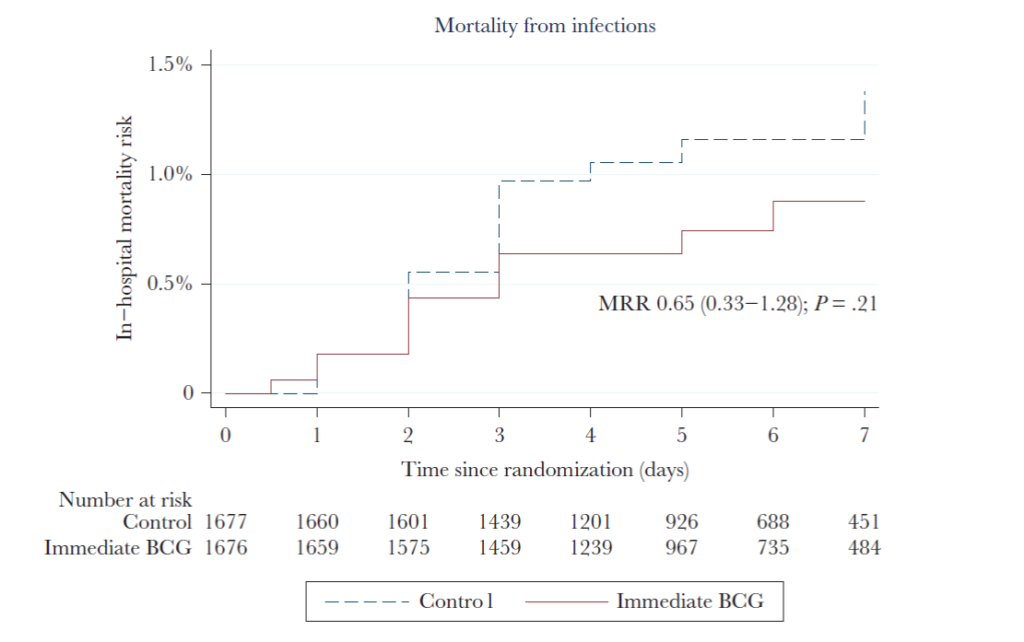Journal articles
Bandim Health Project has published more than 1000 journal articles. Full list available here. Below an overview of some of the most recent publications.
Beneficial non-specific effects of live vaccines against COVID-19 and other unrelated infections
The Lancet Journal of Infectious Diseases
Peter Aaby, Mihai G Netea, Christine S Benn

Live attenuated vaccines could have beneficial, non-specific effects of protecting against vaccine-unrelated infections, such as BCG protecting against respiratory infection. During the COVID-19 pandemic, testing of these effects against COVID-19 was of interest to the pandemic control programme. Non-specific effects occur due to the broad effects of specific live attenuated vaccines on the host immune system, relying on heterologous lymphocyte responses and induction of trained immunity. Knowledge of non-specific effects has been developed in randomised controlled trials and observational studies with children, but examining of whether the same principles apply to adults and older adults was of interest to researchers during the pandemic. In this Personal View, we aim to define a framework for the analysis of non-specific effects of live attenuated vaccines against vaccine-unrelated infections with pandemic potential using several important concepts. First, study endpoints should prioritise severity of infection and overall patient health rather than incidence of infection only (eg, although several trials found no protection of the BCG vaccine against COVID-19 infection, it is associated with lower overall mortality than placebo). Second, revaccination of an individual with the same live attenuated vaccine could be the most effective strategy against vaccine-unrelated infections. Third, coadministration of several live attenuated vaccines might enhance beneficial non-specific effects. Fourth, the sequence of vaccine administration matters; the live attenuated vaccine should be the last vaccine administered before exposure to the pandemic infection and non-live vaccines should not be administered afterwards. Fifth, live attenuated vaccines could modify the immune response to specific COVID-19 vaccines. Finally, non-specific effects of live attenuated vaccines should always be analysed with subgroup analysis by sex of individuals receiving the vaccines.
Impact of COVID-19 Disruptions on Global BCG Coverage and Paediatric TB Mortality: A Modelling Study
Vaccines
Nabila Shaikh, Puck T. Pelzer, Sanne M. Thysen, Partho Roy, Rebecca C. Harris, Richard G. White

The impact of COVID-19 disruptions on global Bacillus Calmette-Guérin (BCG) coverage and paediatric tuberculosis (TB) mortality is still unknown. To fill this evidence-gap and guide mitigation measures, we estimated the impact of COVID-19 disruptions on global BCG coverage and paediatric TB mortality. First, we used data from multiple sources to estimate COVID-19-disrupted BCG vaccination coverage. Second, using a static mathematical model, we estimated the number of additional paediatric TB deaths in the first 15 years of life due to delayed/missed vaccinations in 14 scenarios—varying in duration of disruption, and magnitude and timing of catch-up. We estimated a 25% reduction in global BCG coverage within the disruption period. The best-case scenario (3-month disruption, 100% catch-up within 3 months) resulted in an additional 886 (0.5%) paediatric TB deaths, and the worst-case scenario (6-month disruption with no catch-up) resulted in an additional 33,074 (17%) deaths. The magnitude of catch-up was found to be the most influential variable in minimising excess paediatric TB mortality. Our results show that ensuring catch-up vaccination of missed children is a critical priority, and delivery of BCG alongside other routine vaccines may be a feasible way to achieve catch-up. Urgent action is required to support countries with recovering vaccination coverages to minimise paediatric deaths
Assessing gender differences among presumed and diagnosed patients with pulmonary TB: observations from Guinea-Bissau
Transactions of The Royal Society of Tropical Medicine and Hygiene
Anders Solitander Bohlbro, Antonio Matteus Mendes, Armando Sifna, Cecilie Blenstrup Patsche, Victor Gomes, Christian Wejse, Frauke Rudolf
Background: Globally, more males than females are diagnosed with pulmonary TB (PTB); however, the cause of this gender disparity remains unknown. We aimed to assess gender differences in an observational cohort of patients with presumed PTB (prePTB) at the Bandim Health Project, Guinea-Bissau.
Methods: Adult patients with signs and symptoms suggestive of PTB seeking medical care were invited to participate and were referred to comprehensive diagnostic work-up.
Results: We included 2020 patients with prePTB; 54.6% were female. Females were younger than males and more often infected with HIV. More male patients with prePTB were diagnosed with PTB and the proportion of smear-positive cases was greater among males. There was no gender difference in loss to follow-up during the diagnostic process. Of 219 patients with PTB, 205 started treatment, with no difference between genders regarding pretreatment loss to follow-up or treatment outcome.
Conclusions: More women sought help for symptoms indicative of PTB, yet more men were diagnosed. Women did not have more clinically severe disease at presentation, did not drop out of diagnostic procedures more frequently and did not experience a worse outcome than men. This suggests that the gender gap in PTB is unlikely to be due solely to differences in care-seeking behaviour or diagnostic procedures in our setting.
Coverage and factors associated with receiving campaign polio vaccines in an urban population in Guinea-Bissau
ScienceDirect
M Buus, I da Silva, S Nielsen, S M Thysen, A B Fisker
Background: Polio eradication campaigns are intended to complement routine immunization. Studies addressing factors associated with campaign coverage are warranted to identify children missed by campaigns.
Methods: Bandim Health Project runs demographic surveillance with registration of routine immunization and campaign participation data in urban Guinea-Bissau. We assessed coverage and factors associated with receiving campaign polio vaccines in children aged 0-35 months in two polio eradication campaigns conducted in 2017 and 2018 using univariate and multivariate regression models.
Results: Campaign coverage reached 84% in 2017 and 88% in 2018. We found lower coverage among children of young and not formally educated mothers in univariate analyses; Children <9 months and Fula children had lower campaign coverage in both univariate and multivariate analyses.
Conclusions: To increase campaign coverage in urban Guinea-Bissau attention may be directed at informing young mothers, mothers of young children, mothers without formal education, and the Fula ethnic group about campaigns.
Keywords: Immunization coverage; Oral polio vaccine; Supplementary immunization activities.
Oral Polio Vaccine Campaigns May Reduce the Risk of Death from Respiratory Infections
Sebastian Nielsen, Hasan Mahmud Sujan, Christine Stabell Benn, Peter Aaby, Syed Manzoor Ahmed Hanifi

Oral polio vaccine (OPV) campaigns, but not other campaigns, have been associated with major reductions in child mortality. Studies have shown that OPV reduces the risk of respiratory infections. We analysed the causes of death at 0-2 years of age in Chakaria, a health and demographic surveillance Systems in Bangladesh, in the period 2012-2019 where 13 national campaigns with combinations of OPV (n = 4), vitamin A supplementation (n = 9), measles vaccine (MV) (n = 2), and albendazole (n = 2) were implemented. OPV-only campaigns reduced overall mortality by 30% (95% confidence interval: -10-56%). Deaths from respiratory infections were reduced by 62% (20-82%, p = 0.01) in the post-neonatal period (1-35 months), whereas there was as slight increase of 19% (-37-127%, p = 0.54) for deaths from other causes. There was no benefit of other types of campaigns. Hence, the hypothesis that OPV may have beneficial non-specific effects, protecting particularly against respiratory infections, was confirmed.
Immediate Bacille Calmette-Guérin vaccination to neonates requiring perinatal treatment at the maternity ward in Guinea-Bissau: A randomized controlled trial
The Journal of Infectious Diseases
Frederik Schaltz-Buchholzer, Peter Aaby, Ivan Monteiro, Luis Camala, Simone Faurholt Simonsen, Hannah Nørtoft Frankel, Kristina Lindberg Larsen, Christian N Golding, Tobias R Kollmann, Nelly Amenyogbe, Christine Stabell Benn, Morten Bjerregaard-Andersen

Background: Randomized controlled trials (RCTs) indicate that Bacille Calmette-Guérin (BCG) vaccination provides broad beneficial non-specific protection against infections. We investigated the effect on in-hospital mortality of providing BCG immediately upon admission to a neonatal intensive care unit (NICU), rather than BCG-at-discharge. The pre-trial NICU mortality was 13% and we hypothesized that BCG would reduce mortality by 40%.
Methods: Parallel-group, open-label RCT initiated in 2013 in Guinea-Bissau. NICU-admitted neonates were randomized 1:1 to BCG+Oral Polio Vaccine (OPV) immediately (intervention) versus BCG+OPV at hospital discharge (control; usual practice). The trial was discontinued due to decreasing in-hospital mortality and major NICU restructuring. We assessed overall and disease-specific mortality by randomization allocation in Cox Proportional Hazards models providing Mortality Rate Ratios (MRRs).
Results: We recruited 3,353 neonates and the overall mortality was 3.1% (52/1676) for BCG-vaccinated neonates versus 3.3% (55/1677) for controls, MRR=0.94 (0.64-1.36). For non-infectious causes of death the MRR was 1.20 (0.70-2.07) and there tended to be fewer deaths from infections in the BCG group (N=14) than among controls (N=21), MRR=0.65 (0.33-1.28).
Conclusions: Providing BCG+OPV to frail neonates was safe and might protect against fatal infection in the immediate newborn period. Deaths due to prematurity and perinatal complications were unaffected by BCG.
